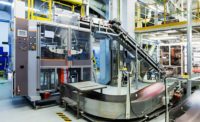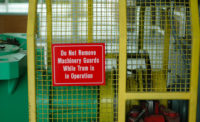2020 Top Standards: OSHA most frequently violated standards
Machine Guarding (1910.212)

Machine Guarding (1910.212) was the ninth most-frequently cited agency standard in FY 2019.
Enforcement citations FY 2019: 1,820
Number of inspections: 1,654
Proposed penalties: $12,451,739
Most frequently cited industries:
Fabricated Metal Product Manufacturing was the most-cited industry for violations of 1910.212 in FY 2019, with 423 citations, 371 inspections and $2,409,690 in proposed penalties. In the number two position: Food Manufacturing, (176 citations, 166 inspections and $1,465,678 in penalties). Machinery Manufacturing had 130 citations, 109 inspections and $756,822 in penalties. Plastics and Rubber Products Manufacturing employers were cited 129 times, inspected 113 times and had proposed penalties of $1,266,048.
Wood Product Manufacturing had 86 citations, 84 inspections and $614,815 in penalties. Transportation Equipment Manufacturing companies were cited 86 times for violations arising from 75 inspections, with penalties totaling $540,515. Paper Manufacturing and Primary Metal Manufacturing each had 64 citations and 60 inspections, with $513,674 and $433,322 in penalties, respectively. Nonmetallic Mineral Product Manufacturing operations were inspected 52 times and earned 59 citations, with $522,674 in penalties. Merchant Wholesalers, Durable Goods employers were cited 55 times from 51 inspections, with $288,780 in penalties.
Hazards
Moving machine parts have the potential to cause severe workplace injuries, such as crushed fingers or hands, amputations, burns, or blindness. Employee exposure to unguarded or inadequately guarded machines is prevalent in many workplaces. Consequently, workers who operate and maintain machinery suffer approximately 18,000 amputations, lacerations, crushing injuries, abrasions, and more than 800 deaths per year.1
Amputation is one of the most severe and crippling types of injuries in the workplace, and often results in permanent disability. Amputations occur most often when workers operate unguarded or inadequately safeguarded mechanical power presses, power press brakes, powered and non-powered conveyors, printing presses, roll-forming and roll-bending machines, food slicers, meat grinders, meat-cutting band saws, drill presses, and milling machines as well as shears, grinders, and slitters. These injuries also happen during materials handling activities and when using forklifts and doors as well as trash compactors and powered and non-powered hand tools. Besides normal operation, the following activities involving stationary machines also expose workers to potential amputation hazards: setting up, threading, preparing, adjusting, cleaning, lubricating, and maintaining machines as well as clearing jams.2
Hazards in many industries
Different industries have different machine guarding risks. Farm workers, for example, are at high risk of scalping and other severe injuries if their hair becomes entangled around the inadequately guarded rotating drivelines or shafts of farm machinery driven by power take-offs (PTOs). Such entanglement of hair, clothing, or body parts kills and injures many farm workers each year.
In the stone-cutting industry, machines called stone masons, stone cutters, stone splitters, and rock cutters have hydraulically operated rams to split and cut various types of stone products used mainly for decorative purposes in the landscaping industry. Stone-cutting machines with unguarded cutting blades can cause amputations and other serious injuries.
Safeguards are essential for protecting workers from these preventable injuries. Any machine part, function, or process that may cause injury must be safeguarded. When the operation of a machine or accidental contact injure the operator or others in the vicinity, the hazards must be eliminated or controlled.
Key provisions
One or more methods of machine guarding must be provided, in order to protect the operator and other employees in the machine area from hazards such as those created by point of operation, ingoing nip points, rotating parts, flying chips and sparks. Examples of guarding methods are: barrier guards, two-hand tripping devices, electronic safety devices, etc.
Guards shall be affixed to the machine where possible and secured elsewhere if for any reason attachment to the machine is not possible. The guard shall be such that it does not offer an accident hazard in itself.
The point of operation: the area on a machine where work is actually performed upon the material being processed - must be guarded with a device that is designed and constructed as to prevent the operator from having any part of his body in the danger zone during the operating cycle.
Special hand tools for placing and removing material shall be such as to permit easy handling of material without the operator placing a hand in the danger zone. Such tools shall not be in lieu of other guarding that’s required, but can only be used to supplement protection provided.
Some of the machines which usually require point of operation guarding are guillotine cutters, shears, alligator shears, power presses, milling machines, power saws, jointers, portable power tools, forming rolls and calenders.
Revolving drums, barrels, and containers must be guarded by an enclosure which is interlocked with the drive mechanism, so that the barrel, drum, or container cannot revolve unless the guard enclosure is in place.
Exposure of blades: when the periphery of the blades of a fan is less than seven (7) feet above the floor or working level, the blades shall be guarded. The guard shall have openings no larger than one-half (1/2) inch.
Machines designed for a fixed location shall be securely anchored to prevent walking or moving.
General machine guarding safety measures
- Identify the hazards of the machines being used.
- Conduct regular inspections and keep machinery clean and properly maintained.
- Train workers on machine-operating procedures.
- Establish procedures for addressing unsafe conditions.
- Ensure that only trained workers operate machinery and that they do not wear loose-fitting clothing that could become entangled in the machinery.
- Prohibit other workers from being near the machine during operations.
Compliance assistance
Protect Yourself – Amputations: an OSHA QuickCard™ that discusses amputations and the best way to prevent them.
Safeguarding Equipment and Protecting Workers from Amputations (PDF). OSHA Publication 3170. Provides information to help identify and manage common amputation hazards associated with operating and using stationary equipment.
Hazards of Operating Unguarded Stone Cutters and Splitters in Landscaping and Other Worksites. OSHA Safety and Health Information Bulletin (SHIB).
OSHA’s Machine Guarding eTool provides information on how to recognize and control common amputation hazards associated with operating certain types of machines.
References
|
2020 Top Standards Article Index ANSI/ISEA 121- Dropped object prevention solutions NFPA 652 standard on fundamentals of combustible dust OSHA most frequently violated standardsFall protection- General Requirements (1926.501) Hazard Communication (1910.1200) The Control of Hazardous Energy (Lockout/Tagout) 1910.147 Respiratory Protection (1910.134) Powered Industrial Trucks (1910.178) |
Looking for a reprint of this article?
From high-res PDFs to custom plaques, order your copy today!








.jpg?t=1721257160)